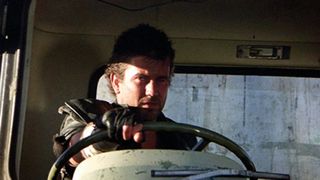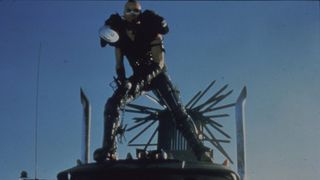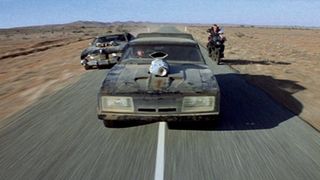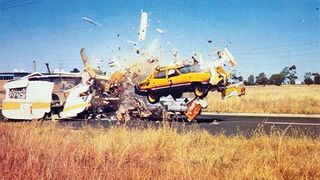“We don’t need another hero!” belts out Tina Turner during the closing title song to Mad Max Beyond Thunderdome, the third chapter of George Miller’s angst ridden, post apocalyptic fantasy franchise. In our cluttered age of cinematic superheroes some might finally be willing to agree with her. However, following a 30-year absence from our screens the renegade policeman is wandering the desolate wastelands again in Mad Max: Fury Road. Max Rockatansky was never really one for heroics anyway.
“He’s a reluctant hero, driven purely by necessity who inadvertently becomes involved… a character in a brutal world trying to avoid his brutal nature,” observed Miller. At this most primal level Rockatansky is the mythical gunslinger of Western mythology, the samurai warrior of Japanese legend who, when provoked, turns very mad indeed.

Fury fuelled the original film’s production too, lending it a raw and visceral quality. No doubt Miller’s exposure to the horrific aftermaths of car crash patients while working as an emergency ward doctor left an almighty impression on the young film enthusiast. It was during this time, while attending summer film school, that Miller met his future creative partner Byron Kennedy.
Eight years later in December 1978, with a script complete, a then unknown 21-year-old Mel Gibson cast in the lead and on a shoestring budget Miller and Kennedy commenced their 12-week shoot in Australia’s Melbourne hinterland. The eye-opening ramifications of the Australian oil crisis of 1973, revealing the violent extremes motorists would go to in order to obtain fuel for their cars, ignited Miller’s determination to create a post-industrial society where roads were ruled by a fearsome group of delinquents who unleashed terror on the highways.

And in the words of the seemingly demonic Nightrider character from the film’s frenetic opening car chase it was “a fuel-injected suicide machine!” Take the filming of the fiery demise of that character, which took three days to film (for only four seconds of screen time) and utilised a fuel rocket motor to send its souped up Holden Monaro to speeds of up to 75mph in 36 metres, or the time director of photography David Eggby fearlessly mounted the back of a motorbike travelling at 110mph to capture the intense exhilaration of speed. “Hand-holding the camera on the back of the motorcycle enabled me to maintain a correct horizon when cornering,” says Eggby. “It was a couple of days later at rushes when we noticed the speedo in the bottom of frame was touching 180kph! We did some crazy things then that you wouldn’t be allowed to do now.
I was too young and gung-ho to be nervous.” The ramshackle shooting environment made use of real biker gangs like the Hells Angels and ignored laws prohibiting filming and performing stunts on open roads at such dangerous velocities. Miller was acutely aware that he was breaking new ground, even if the time-consuming style of filmmaking occasionally disgruntled cast and crew.
“He knew what he wanted and alienated many a crew member and actor in his quest to get what his vision intended,” remembers actor Roger Ward who played Fifi Macaffee, Max’s bald-headed rambunctious police superior. “I remember standing around for what seemed like hours while George stared at the ground, obviously spinning through his mind the sequences of events he visualised and how he could transpose them to film. I would have wilted under the hostility he was exposed to but George was adamant and would not begin to shoot until he knew what he wanted.”
Key daredevil collaborators aided the young filmmaker. There was assistant director Ian Goddard, one of Europe’s top motorcyclists, and legendary Australian stuntman Grant Page. The latter even performed a stunt where a car smashes through a caravan while his leg was still in plaster from a previous injury. Aussie biker and stuntman Gerry Gauslaa even broke a world record when he drove his four-cylinder motorcycle over 28 metres and jumped off the bike in mid-flight.

When it was released internationally in 1980, Mad Max was a triumphant success, becoming the highest budget-to-cost ratio of a motion picture until The Blair Witch Project in 1999. Not bad for a film edited in the director’s house. Despite critics largely deriding it for its apparent senseless violence, audiences lapped up the feel of being thrust from their seats and into the midst of the action. Aided by Australian composer Brian May’s gothic and erratic score this relentless vengeance flick packed an emotional and visceral punch.
Mad Max 2 takes place almost immediately after events in the first film, with a pre-titles monologue setting the post-nuclear tribal warfare scenario. The plot was a masterstroke in linear simplicity: in essence one long chase, which sees our antihero transformed into a relentless scavenger who reluctantly elopes with an idealistic tribe to drive a semi-trailer containing gallons of petrol from their isolated oil refinery to a distant coastal outpost. “We made it very minimalist in terms of dialogue in order to tell as much of it as possible in purely film language,” said Miller. Indeed, Gibson voices just 12 lines of dialogue in the entire movie, which helps re-enforce the tarnished “burnt out shell of a man” that Max has become.

Less on the quiet side was the quirky Gyro Captain that Max encounters early on, played by Australian character actor Bruce Spence. “I could see the similarities between the Gyro Captain and Max in terms of that relationship you had in some Westerns where the hero has an off-sider who is a little warmer and slightly humorous,” considers Spence. “George and I sat down and watched Shane and Yojimbo. Kurosawa movies tend to have a strange, outrageous offside character.”
The progressively desolate surroundings also lent texture to a character that had to adapt to his environment in order to survive. “The character didn’t have much of a name but the background was what was important,” says Spence. “There was certainly an ambivalent morality about him, hence his confrontation with Max, which creates a journey for the character later on when Max finds himself in dire circumstances.” It also helped that Miller created a sense of spontaneity on set, encouraging an off-the-wall way of looking at this world. “It was like a circus at times – all these strange people, dressed weirdly and all these unusual automobiles,” says Spence. “It had that air of anarchic masculinity and testosterone about it.”
And a Mad Max movie wouldn’t be a Mad Max movie without an adrenaline-induced car chase sequence. The sequel climaxes with arguably the greatest pursuit of them all: an oil tanker driven across an open desert track pursed by a hellish band of leather-clad foes in monster cars that lasts a relentless 12 minutes of screen time.
A superbly gritty and gutsy addition to the series that was released to huge acclaim, Mad Max 2 is (thus far) widely considered the definitive film of the franchise. But tragedy struck in 1983 when Miller’s creative partner Byron Kennedy was killed in a helicopter crash. After much contemplation and spurred on by the success of the first two Mad Max films the filmmaker decided to honour his late friend by taking the story into bold new territory with Mad Max Beyond Thunderdome – co-directed with George Ogilvie.

Fifteen years on we find Max in even worse shape than before: shoeless and destitute in a desert world where roads no longer exist. His only means of transportation is a ramshackle camel-driven wagon, which is soon stolen. Scribe Terry Hayes considered his take on the character as “Jesus Christ in leather pants”. The analogy wouldn’t be too far off the mark with our wayward drifter happening upon the bustling and brutal Bartertown. There Max agrees to fight the esteemed leader Masterblaster in the notorious Thunderdome, only to have a change of heart and be punished in the unforgiving all-encompassing dunes. Here he eventually sacrifices himself to save a colony of lost children who see him as their natural saviour. A familiar face then joins the journey for the frenetic climax.
“I always thought it was a completely different story from Mad Max 2 so I wasn’t expecting it,” considers Bruce Spence on the surprise of being ushered back into the series. “They were well into the shoot when they offered me a part described as ‘not the Gyro Captain but kind of like the Gyro Captain!’” he reflects on the role of the equally sky-bound character of Jedediah the Pilot. “They said there’s kind of a reflection of him and that they were having difficulty casting the role so they thought to themselves, ‘Why not Bruce!’” Once more Spence found himself resuming an odd couple partnership with his leading man. “Mel’s natural aloofness and his character aloofness worked well for me and I could play off that,” he says. “The character clash is what creates the drama. An uneasy alliance between two characters is much more dramatic than a very platonic and easygoing one.”

Inching towards more traditional sci-fi with a mega budget that could employ ’80s rock star Tina Turner as a flamboyant Amazonian antagonist, Mad Max Beyond Thunderdome encompasses expansive locations, multiple storylines and a vast array of characters. “When I came into it I was just one of many,” Spence considers. “It was a chaotic shoot with a busy story and totally different to my experience on Mad Max 2 which was more intimate. I wasn’t quite sure of my character’s journey as there was a lot more mystery to him, but I really liked the end which justified all the early stuff that happened.”
But Max’s journey doesn’t end there. Tom Hardy takes over Gibson’s mantle in the title role in Miller’s long-delayed, highly anticipated follow up. Mad Max 2 stuntman Guy Norris returned to the franchise as a stunt coordinator for the fourth instalment and offers some intriguing insights. “I would describe Fury Road as combining Mad Max and Mad Max 2 on steroids,” he says promisingly. “The stunts were certainly larger, much more elaborate and performed for real at high speed. CGI was only used to remove the safety cables,” he adds reassuringly.

“It’s taken George a long time to make this and I think there is something he wants to say about this world right now,” considers Spence. “I know from what I’ve heard that this film won’t be like any of the others. I’m positive he’s going to blast people out of their chairs!”
Click here for more excellent SFX articles. Or maybe you want to take advantage of some great offers on magazine subscriptions? You can find them here.
